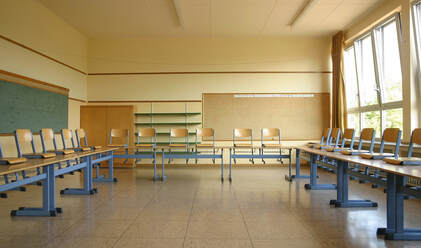|
By: Annika Kunz Lockers, long hallways, and cheerleaders – just three of the common images I have come to expect in any American high school thanks to movie stereotypes and tropes. While Netflix may have gotten some of it right, a comparison of Glenelg and Lessing High School in Sachsen, Germany reveals some interesting differences between the two countries’ high school learning environments. The American school system is often used as the model example in conversations about different educational systems, mainly for students’ ability to choose classes depending on their interests.. American schools often offer a variety of individual classes, which gives students the opportunity to choose classes that address specific topics and skills. In German schools, students are not able to select between classes, which means they have around 16 different classes per week (5 science, 2-3 art, 3 social studies, 3-4 languages, PE, and Math). The normal German school day looks much different as well - longer breaks, longer periods and different ending times every day. A normal period in a German high school lasts 90 minutes which gives the chance to get way more work done but also makes it difficult to concentrate through the whole period. The first two periods and the last two are “split” periods that last only 45 minutes. Between every period, there is a 10 minute break; after the first period there is a 30 minute break. The lunch period lasts 50 minutes and every student has lunch at the same time. Some students choose to leave school to eat lunch and either walk to the nearest food store, or walk home if they live close enough. The length of the school day changes depending on which classes you have on which day. Some days there are five classes, others there can be up to 10 periods. Some periods begin as early as 7am and can end as late as 4:00pm. In Germany, the learning environment is often more formal, with students listening attentively to the teacher and fewer opportunities for interactive discussions. In the U.S, lessons tend to be more interactive and creative. The American approach to after-school-activities is another aspect that stands out. American high schools, at least from what I’ve seen at Glenelg, offer a variety of clubs, sports, and artistic programs. The emphasis on a well-rounded education is evident, with students encouraged to explore a variety of interests beyond academics. In contrast, German schools often have a more streamlined approach, with extracurricular activities taking a back seat to academic rigor. Grading systems also differ significantly. In Germany, the grading scale is often numerical, with 1 being the best and 6 the lowest. In the U.S., a letter grading system is employed, ranging from A to E. Navigating this shift has been both challenging and enlightening, requiring a recalibration of my understanding of academic success. Finally, the concept of school spirit is a phenomenon that has truly captivated me during my time in the United States. Pep rallies, homecoming events, and spirited sports games are integral parts of the American high school experience, fostering a sense of community and belonging. German schools, while fostering strong academic connections, do not often place as much emphasis on the vibrant social aspects that make American high schools so lively. Seeing all the differences between both school systems and experiencing how it is done differently gives me the opportunity to have a new perspective on why certain things are handled this way. The American schools system lets you focus more on your interests and future plans while the German schools system provides more of a well-rounded education.
1 Comment
6/11/2024 11:28:22 pm
What implications does the difference in class selection have for students' educational experiences?
Reply
Leave a Reply. |
Archives
May 2024
|
